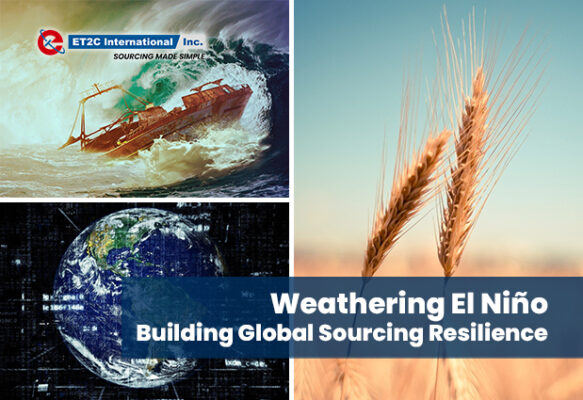
Explore the effects of El Niño on global sourcing and shipping and how to build a robust risk mitigation plan to proactively address the potential trading impacts of El Niño.

Introduction
Global weather patterns play a significant role in shaping various industries, including global sourcing and shipping. One such weather phenomenon is El Niño, which occurs periodically and affects sea surface temperatures in the central-east equatorial Pacific. El Nino is more than an interesting and infrequent weather pattern. It has demonstrated the potential to disrupt economies, sourcing strategies, and global trade.
Understanding El Niño
El Niño, a Spanish term meaning “the boy,” refers to the warming of sea surface temperatures in the tropical eastern Pacific. This climate event typically occurs every few years and has significant implications for weather patterns worldwide. When sea temperatures in the tropical eastern Pacific rise 0.5°C above the long-term average, an El Niño is declared.
The effects of El Niño are most strongly felt in the tropical eastern Pacific, where warmer-than-average weather conditions prevail. The phenomenon was named El Niño de Navidad (the boy of Christmas) centuries ago by Peruvian fishermen, who observed its occurrence during the holiday season.
Impact on Global Sourcing Strategies
El Niño can have various impacts on global sourcing strategies, both from the supply and demand side. Changing weather patterns associated with El Niño can lead to shifts in consumer behavior, affecting the demand for specific products. In areas experiencing increased temperatures or power outages, consumers may seek cooling products such as air conditioners, Fans and Generators leading to a surge in demand.
On the supply side, El Niño can disrupt agricultural production worldwide. It can cause droughts in some regions and heavy rainfall in others, directly impacting crop yields and livestock production. The agricultural sector’s vulnerability to El Niño necessitates careful planning and adaptation in global sourcing strategies.
Disruption of Shipping and Logistics
El Niño’s impact on weather conditions can disrupt maritime transportation, affecting global supply chains. Altered weather patterns, including storms and increased wave heights, can lead to port closures, shipment delays, and increased transportation costs. Trade flows may be affected, hindering the timely delivery of goods and increasing logistical challenges.

Natural Resources and Commodities
El Niño has the potential to influence the availability and prices of various natural resources and commodities. Fishing industries can be negatively impacted, as El Niño disrupts marine ecosystems and alters fish migration patterns. Additionally, arable farming may suffer from water scarcity or excessive rainfall, affecting crop yields. The fluctuations in natural resources and commodities due to El Niño can have broad implications for global sourcing and trade.
Scenario Planning, Adaptation and risk Mitigation
Given the potential risks posed by El Niño, companies engaged in global sourcing should incorporate scenario planning and adapt their sourcing strategies accordingly. By anticipating the potential trading impacts of El Niño, businesses can make early adjustments to their supply chain management and mitigate potential disruptions. Developing a plan requires a proactive and comprehensive approach1.
1.Monitor and Assess: Stay informed about El Niño forecasts and developments through reliable sources, such as meteorological agencies and climate monitoring organizations. Understand the potential impacts on key sourcing regions, transportation routes, and commodity markets relevant to your business.
2. Diversify Sourcing: Identify regions and suppliers that are less susceptible to El Niño impacts. Diversify your sourcing base across different countries or regions to minimize the risk of disruptions caused by adverse weather conditions or agricultural supply constraints. Consider the resilience and climate patterns of potential sourcing locations.

3. Supplier Risk Assessment: Assess the vulnerability of your key suppliers to El Niño-related risks. Engage in open communication with suppliers to understand their contingency plans and evaluate their ability to manage disruptions caused by extreme weather events.
4. Supply Chain Resilience: Strengthen your supply chain resilience by developing alternative sourcing options and multiple transportation routes. Collaborate with logistics providers to identify backup routes and modes of transportation in case of disruptions.
5. Risk Insurance and Financial Planning: Consider obtaining appropriate insurance coverage to mitigate financial risks associated with supply chain disruptions. Evaluate your business interruption insurance, cargo insurance, and other relevant policies to ensure they cover potential losses caused by El Niño impacts.
6. Continuous Monitoring and Communication: Regularly monitor the progress and severity of El Niño events and reassess your risk mitigation strategies accordingly. Establish a robust communication system within your organization and with suppliers to ensure prompt response and coordination in case of disruptions. Stay connected with industry associations and networks for updated information and best practices.
By taking these steps, companies can enhance their preparedness and resilience to mitigate the risks associated with El Niño on global trade and sourcing. It’s crucial to regularly review and update your risk mitigation plan as El Niño patterns and risks evolve over time.
Conclusion
El Niño, a recurring weather phenomenon, can significantly impact global sourcing and shipping. From disrupting agricultural production to affecting energy generation, transportation, and commodity prices. It can also create demand in new categories as consumer and customers respond to the weather effects.
Understanding the potential risks and incorporating adaptive strategies, companies can navigate the challenges posed by El Niño and ensure the resilience of their global sourcing operations.
How can we help
ET2C are a leading Global Sourcing Company, working with our clients for over 20 years to Make Global Sourcing Simple. We have over 250 colleagues based in seven offices across the globe to give you feet on the ground and become your bridge to your sourcing markets.
If you would like to discuss El Nino potential impacts or building a risk mitigation plan please drop us a line at contact@et2cint.com

